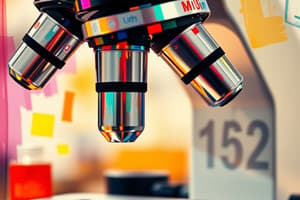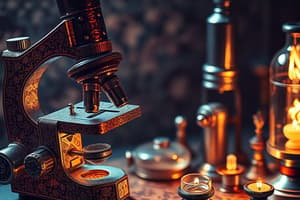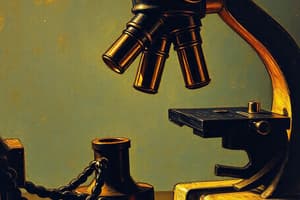Podcast
Questions and Answers
Which part of a microscope primarily controls the amount of light reaching the specimen?
Which part of a microscope primarily controls the amount of light reaching the specimen?
- Coarse adjustment knob
- Ocular lens
- Objective lens
- Condenser (correct)
All living organisms are capable of producing their own food through photosynthesis.
All living organisms are capable of producing their own food through photosynthesis.
False (B)
What is the basic structural and functional unit of all known living organisms, as stated by the cell theory?
What is the basic structural and functional unit of all known living organisms, as stated by the cell theory?
cell
The process by which a cell engulfs large particles or other cells is known as ______.
The process by which a cell engulfs large particles or other cells is known as ______.
Match the following cell organelles with their primary functions:
Match the following cell organelles with their primary functions:
Which of the following is a characteristic of asexual reproduction?
Which of the following is a characteristic of asexual reproduction?
In an ecosystem, decomposers obtain their energy by consuming producers directly.
In an ecosystem, decomposers obtain their energy by consuming producers directly.
Define what a food web represents in an ecosystem, in terms of energy transfer.
Define what a food web represents in an ecosystem, in terms of energy transfer.
In ecological terms, a ______ refers to all the populations of different species that live and interact in a particular area.
In ecological terms, a ______ refers to all the populations of different species that live and interact in a particular area.
Which of the following ecological relationships involves one species benefiting and the other being harmed?
Which of the following ecological relationships involves one species benefiting and the other being harmed?
The biosphere is the broadest and most inclusive level of ecological organization.
The biosphere is the broadest and most inclusive level of ecological organization.
How does the transfer of energy occur from one trophic level to the next in a food chain?
How does the transfer of energy occur from one trophic level to the next in a food chain?
The Intertropical Convergence Zone (ITCZ) is characterized by ______ pressure and rising air.
The Intertropical Convergence Zone (ITCZ) is characterized by ______ pressure and rising air.
What causes the monsoon season in many parts of the world?
What causes the monsoon season in many parts of the world?
Land breezes typically occur during the daytime due to the land heating up faster than the sea.
Land breezes typically occur during the daytime due to the land heating up faster than the sea.
What is the primary cause of Earth's seasons?
What is the primary cause of Earth's seasons?
During the summer solstice in the Northern Hemisphere, the ______ Hemisphere receives the most direct sunlight.
During the summer solstice in the Northern Hemisphere, the ______ Hemisphere receives the most direct sunlight.
Match each item with the correct part of MRS GRENCELL.
Match each item with the correct part of MRS GRENCELL.
Which of the following is NOT a part of cell theory?
Which of the following is NOT a part of cell theory?
A biome represents a small level of ecological organization, typically focusing on a single community.
A biome represents a small level of ecological organization, typically focusing on a single community.
Flashcards
Base and Arm (Microscope)
Base and Arm (Microscope)
Supports the microscope and is used to carry it.
Ocular Lens (Microscope)
Ocular Lens (Microscope)
The lens you look through (usually 10x magnification).
Objective Lenses (Microscope)
Objective Lenses (Microscope)
Objective lenses that magnify the specimen (4x, 10x, 40x).
Diaphragm (Microscope)
Diaphragm (Microscope)
Signup and view all the flashcards
MRS GRENCELL
MRS GRENCELL
Signup and view all the flashcards
Cell
Cell
Signup and view all the flashcards
Tissue
Tissue
Signup and view all the flashcards
Organ
Organ
Signup and view all the flashcards
Organ System
Organ System
Signup and view all the flashcards
Organism
Organism
Signup and view all the flashcards
Population
Population
Signup and view all the flashcards
Community
Community
Signup and view all the flashcards
Biotic Factors
Biotic Factors
Signup and view all the flashcards
Abiotic Factors
Abiotic Factors
Signup and view all the flashcards
Cell Theory
Cell Theory
Signup and view all the flashcards
Nucleus
Nucleus
Signup and view all the flashcards
Sexual Reproduction
Sexual Reproduction
Signup and view all the flashcards
Food Chain
Food Chain
Signup and view all the flashcards
Food Web
Food Web
Signup and view all the flashcards
Sea Breeze
Sea Breeze
Signup and view all the flashcards
Study Notes
Parts and Function of the Microscope
- The microscope is an instrument that magnifies small objects, revealing details not visible to the naked eye.
- The eyepiece lens (ocular lens) magnifies the image, typically by 10x or 15x.
- The objective lenses are the primary lenses that magnify the specimen, usually with various powers such as 4x, 10x, 40x, and 100x.
- The nosepiece holds the objective lenses and can be rotated to change the magnification.
- The stage is the flat platform where the slide is placed for viewing.
- The stage clips hold the slide in place on the stage.
- The aperture is the hole in the stage through which light passes to illuminate the specimen.
- The illuminator is the light source that provides light for viewing the specimen.
- The condenser focuses the light onto the specimen.
- The diaphragm controls the amount of light that reaches the specimen.
- The coarse adjustment knob is used for large-scale focusing, primarily with lower-power objective lenses.
- The fine adjustment knob is used for precise focusing, especially with high-power objective lenses.
- The arm supports the tube and connects it to the base.
- The base is the bottom of the microscope, providing stability.
Characteristics of Life (MRS GRENCELL)
- Movement: All living organisms exhibit some form of movement, whether internal or external.
- Respiration: Living organisms exchange gases with their environment to produce energy.
- Sensitivity: Organisms respond to stimuli in their environment.
- Growth: Living things increase in size or cell number.
- Reproduction: Organisms produce offspring, either sexually or asexually.
- Excretion: Living organisms eliminate waste products.
- Nutrition: Organisms obtain and process nutrients for energy and growth.
- Cells: All living things are composed of one or more cells.
Levels of Biological Organization
- Atoms: The basic building blocks of matter.
- Molecules: Two or more atoms held together by chemical bonds.
- Organelles: Structures within cells that perform specific functions.
- Cells: The basic unit of life.
- Tissues: Groups of similar cells performing a specific function.
- Organs: Structures composed of different tissues working together.
- Organ Systems: Groups of organs working together to perform complex functions.
- Organism: An individual living thing.
- Population: A group of individuals of the same species living in the same area.
- Community: All the different populations of organisms living in the same area.
- Ecosystem: A community of organisms and their physical environment.
- Biome: A large geographic area characterized by specific climate conditions, animal populations, and plant populations.
- Biosphere: All the ecosystems on Earth.
Cell Theory
- All living organisms are composed of one or more cells.
- The cell is the basic unit of structure and organization in organisms.
- Cells arise from pre-existing cells.
Parts and Functions of an Animal and a Plant Cell
- Cell Membrane: Both plant and animal cells have this outer boundary that controls what enters and exits the cell.
- Nucleus: Contains the cell's genetic material (DNA) and controls cell activities.
- Cytoplasm: The gel-like substance within the cell where organelles are located.
- Ribosomes: Synthesize proteins.
- Endoplasmic Reticulum (ER): Involved in protein and lipid synthesis (Rough ER has ribosomes, Smooth ER does not).
- Golgi Apparatus: Modifies, sorts, and packages proteins and lipids.
- Mitochondria: Produce energy (ATP) through cellular respiration.
- Lysosomes: Contain enzymes to break down waste and cellular debris (more common in animal cells).
- Vacuoles: Store water, nutrients, and waste (larger in plant cells).
- Cell Wall: Provides support and protection (only in plant cells).
- Chloroplasts: Conduct photosynthesis, converting light energy into chemical energy (only in plant cells).
- Centrioles: Involved in cell division (primarily in animal cells).
Microorganisms
- Microorganisms are living organisms that are generally too small to be seen with the naked eye.
- Bacteria: Single-celled prokaryotic organisms and can be beneficial or harmful.
- Archaea: Similar to bacteria but genetically distinct; often found in extreme environments.
- Fungi: Eukaryotic organisms that include yeasts, molds, and mushrooms and obtain nutrients by absorption.
- Protists: A diverse group of eukaryotic microorganisms, including protozoa and algae.
- Viruses: Non-cellular entities that require a host cell to replicate.
- Microorganisms play crucial roles in nutrient cycling, decomposition, and various industrial processes.
- Some microorganisms can cause diseases in plants and animals.
Sexual and Asexual Reproduction
- Asexual Reproduction: Involves one parent and produces genetically identical offspring.
- Binary Fission: A single cell divides into two identical cells (bacteria).
- Budding: A new organism grows from an outgrowth or bud on the parent (yeast, hydra).
- Fragmentation: The parent organism breaks into fragments, each capable of growing into a new individual (starfish, planarians).
- Vegetative Propagation: New plants arise from stems, roots, or leaves of the parent plant (strawberries, potatoes).
- Spore Formation: Production of spores that can develop into new organisms (fungi, ferns).
- Sexual Reproduction: Involves two parents and produces genetically diverse offspring through the fusion of gametes (sperm and egg).
- Meiosis: A type of cell division that reduces the number of chromosomes in gametes.
- Fertilization: The fusion of gametes to form a zygote, which develops into a new organism.
Components of an Ecosystem
- Biotic Factors: The living components of an ecosystem, including plants, animals, fungi, and microorganisms.
- Abiotic Factors: The non-living components of an ecosystem, such as sunlight, water, temperature, soil, and air.
- Producers (Autotrophs): Organisms that produce their own food through photosynthesis or chemosynthesis (e.g., plants, algae, some bacteria).
- Consumers (Heterotrophs): Organisms that obtain energy by consuming other organisms.
- Herbivores: Eat plants
- Carnivores: Eat animals
- Omnivores: Eat both plants and animals
- Decomposers: Break down dead organic matter (e.g., bacteria, fungi).
Ecological Relationships
- Competition: Organisms compete for the same resources (e.g., food, water, space).
- Predation: One organism (the predator) kills and eats another organism (the prey).
- Symbiosis: A close and long-term interaction between two different species.
- Mutualism: Both species benefit.
- Commensalism: One species benefits, and the other is neither harmed nor helped.
- Parasitism: One species (the parasite) benefits, and the other (the host) is harmed.
Ecological Levels of Organization
- Individual: A single organism.
- Population: A group of individuals of the same species living in the same area.
- Community: All the different populations of organisms living in the same area.
- Ecosystem: A community of organisms and their physical environment interacting as a functional unit.
- Biome: A large geographic area characterized by specific climate conditions, animal populations, and plant populations.
- Biosphere: All the ecosystems on Earth, representing the zone of life.
Transfer of Energy (Food Chain and Food Web)
- Food Chain: A linear sequence of organisms through which nutrients and energy pass as one organism eats another.
- Producers → Primary Consumers → Secondary Consumers → Tertiary Consumers → Decomposers
- Food Web: A complex network of interconnected food chains, representing the various feeding relationships within an ecosystem.
- Trophic Levels: The position an organism occupies in a food chain or food web.
- Producers (1st trophic level)
- Primary Consumers (2nd trophic level)
- Secondary Consumers (3rd trophic level)
- Tertiary Consumers (4th trophic level)
- Energy Transfer: Energy is transferred from one trophic level to the next, but only about 10% of the energy is available to the next level (10% rule); the rest is lost as heat.
Land and Sea Breeze, Monsoons, ITCZ
- Land Breeze: Occurs at night when the land cools faster than the sea; air flows from the land to the sea.
- Sea Breeze: Occurs during the day when the land heats up faster than the sea; air flows from the sea to the land.
- Monsoons: Seasonal wind patterns caused by temperature differences between land and sea.
- Summer monsoons bring heavy rainfall as winds blow from the sea to the land.
- Winter monsoons bring dry conditions as winds blow from the land to the sea.
- Intertropical Convergence Zone (ITCZ): A region near the equator where the trade winds converge, resulting in rising air, cloud formation, and heavy precipitation. The ITCZ shifts seasonally with the Sun's position.
Earth’s Tilt and the Seasons
- Earth is tilted on its axis at an angle of 23.5 degrees relative to its orbital plane.
- This tilt causes different parts of the Earth to receive varying amounts of sunlight throughout the year, resulting in seasons.
- During summer, the hemisphere tilted towards the Sun receives more direct sunlight and longer days, while the opposite hemisphere experiences winter.
- During spring and fall, both hemispheres receive roughly equal amounts of sunlight, resulting in moderate temperatures.
Studying That Suits You
Use AI to generate personalized quizzes and flashcards to suit your learning preferences.




